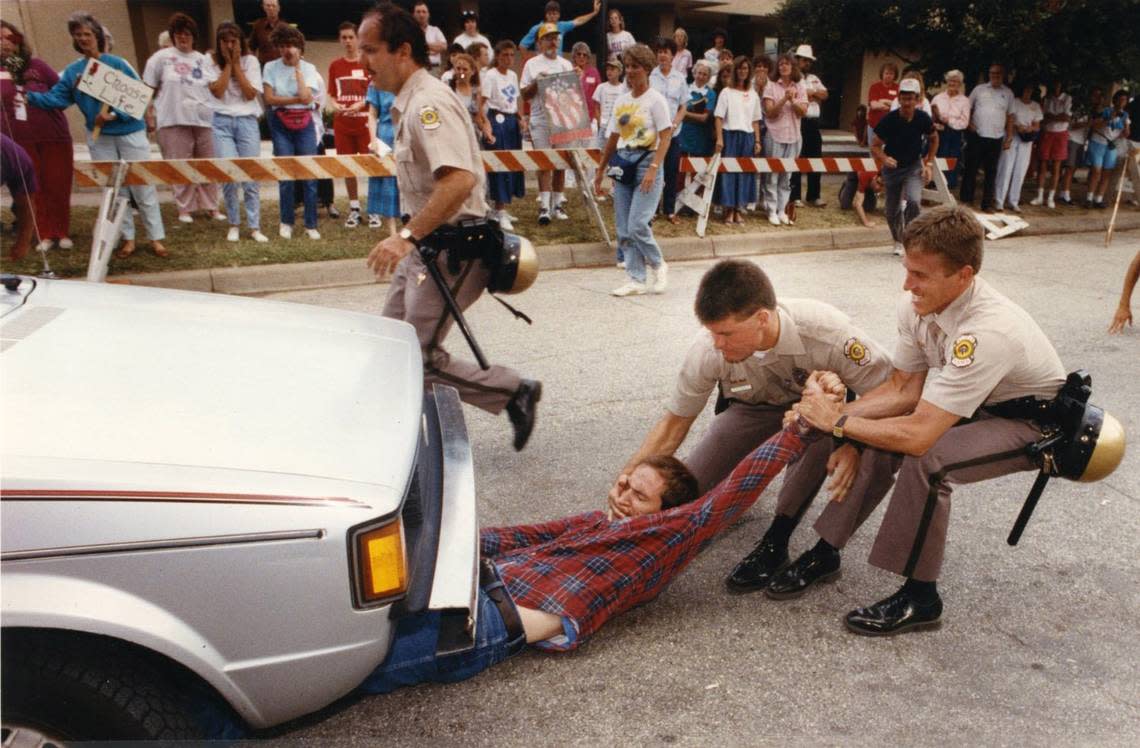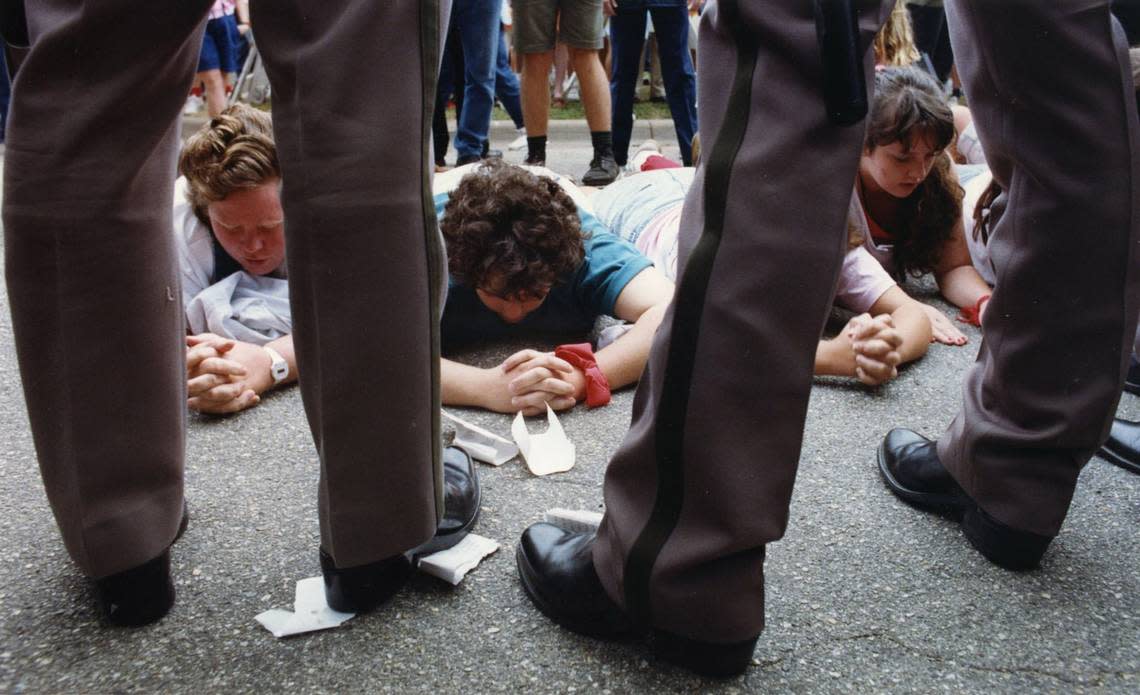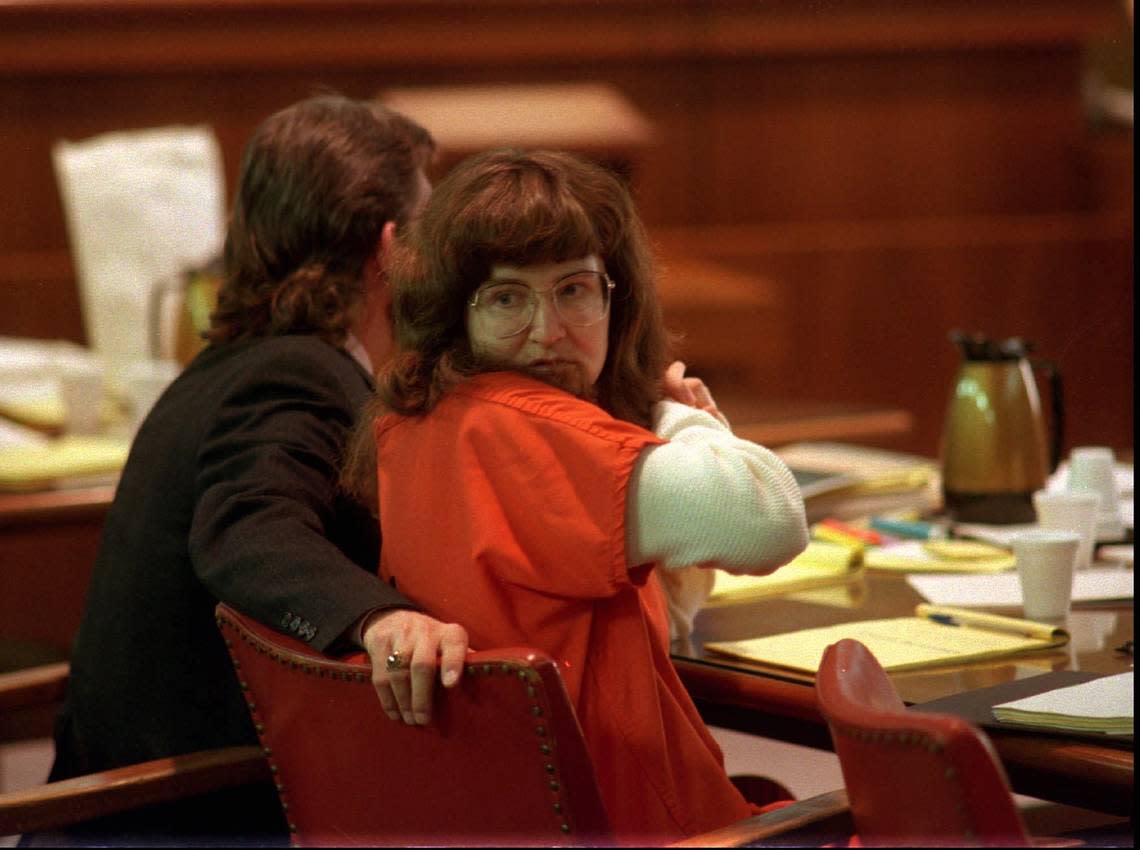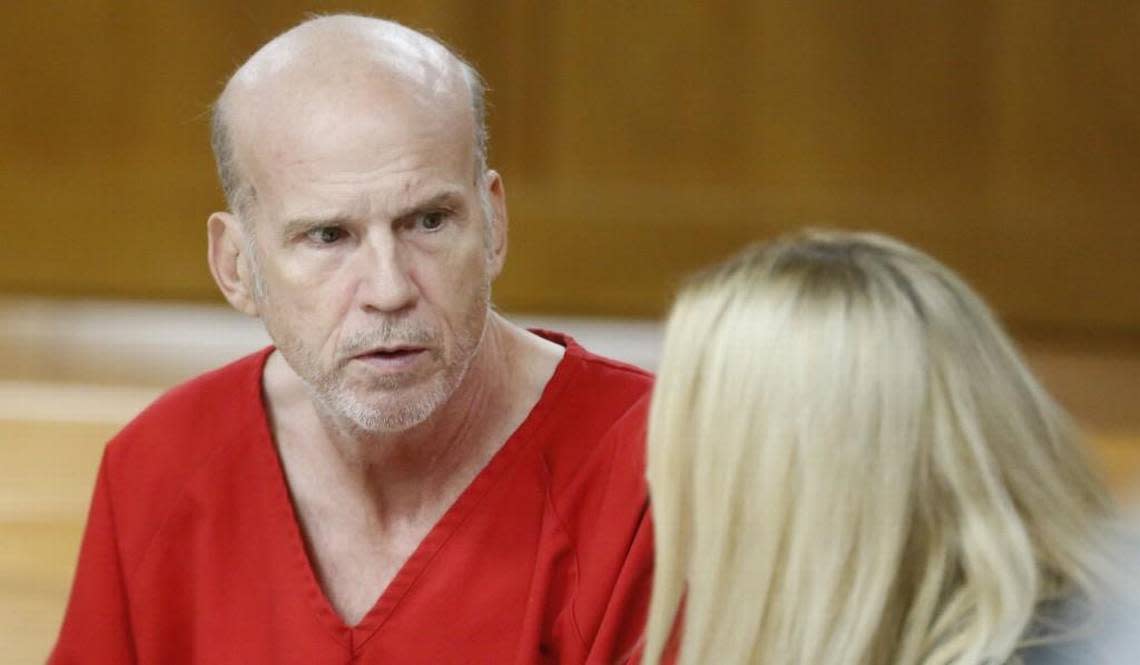‘Summer of Mercy’: How protests changed abortion rights and politics in Kansas forever
They called it the “Summer of Mercy.”
In July and August of 1991, abortion protesters swarmed clinics in Wichita as part of Operation Rescue’s national campaign to shut down the “baby-killing industry” in Kansas — a state that at the time had no restrictions on the procedure. Their main target among the city’s three clinics: George Tiller, one of a handful of doctors in the country who performed late-term abortions.
In the blistering heat, throngs of abortion foes from across the country blocked the clinic gates by day and packed revival-style rallies in a downtown hotel at night, many of them fresh from being arrested.
And as “rescue” leaders stirred up the faithful with fiery speeches and spirited songs, area activists were hard at work at the back of the room. Amid tables teeming with anti-abortion pamphlets and bumper stickers, they were recruiting the locals to run for office. Especially for GOP precinct committee positions, the basic units of grassroots politics that few besides the dedicated insiders typically cared about.
The results of their efforts became evident the following summer. Eighty-three percent of the new Sedgwick County precinct committee members elected in the 1992 Republican primary were abortion opponents, many who had been arrested in the clinic blockades.
Two weeks after the election, they took control of the Sedgwick County GOP, squeezing out abortion-rights advocates who didn’t see it coming. Similar takeovers occurred in Johnson County and other counties in the state.
The 46-day “Summer of Mercy” campaign had pushed abortion opponents out of the pews, into the streets then into the political arena. And in the process, it became a catalyst for anti-abortion activism in Kansas. The state went from having some of the most liberal abortion laws in the country to among the most restrictive.

“It was a firestorm,” said Operation Rescue founder Randall Terry, one of the protest leaders. “We were in a social protest movement that was geared to create political firepower that resulted in abortion being illegal in Kansas. And we’re almost on the cusp of that dream being fulfilled.
“There’s no way that Kansas would be where it is today if not for the ‘Summer of Mercy.’”
Abortion rights advocates say it is a scary place to be, with Kansas again at the center of the abortion debate. On Tuesday, the state will hold the nation’s first ballot test on abortion in the aftermath of the U.S. Supreme Court’s historic ruling last month that overturned Roe v. Wade, the 1973 decision that established a constitutional right to an abortion.
If passed, the ballot initiative would reverse a 2019 state supreme court ruling that found a right to abortion in the Kansas constitution. And lawmakers, for the first time in five decades, would have the power to ban abortion altogether.
But abortion opponents haven’t been talking about that possibility, instead focusing on the need to keep in place 30 years of anti-abortion regulations.
Abortion rights advocates don’t buy it. Earlier this month the Kansas Reflector reported on audio from a Reno County GOP meeting in which a woman identifying herself as a regional director for the primary “vote yes” campaign told voters the plan was to ban abortion, with few exceptions.
Ashley All, the spokeswoman for Kansans for Constitutional Freedom, the main “vote no” group, applauded the “Value Them Both” representative for being “finally honest and forthright about their real goal to ban abortion completely in Kansas.”
“This extreme ban on abortion is absolutely out of step with the values of most Kansans and puts the lives of our daughters, granddaughters and women across the state at serious risk,” All said in a statement.
Protests and politics
The abortion landscape in Kansas is barely recognizable since that summer three decades ago.
In 1991, there were no restrictions on abortion in Kansas. No parental consent requirements for minors or regulations on late-term abortions. Patients traveled to Tiller’s clinic from across the United States because he performed elective abortions through the second trimester of pregnancy — about 26.4 weeks — and in the third trimester in cases of severe fetal abnormalities.
Abortion opponents referred to Kansas as “the abortion capital of the country.” And they answered Operation Rescue’s call to join them in Wichita that July.
“Tiller,” Terry said, “was the magnet.”
The protesters conducted blockades at all three of the city’s abortion clinics, but Tiller’s — which had been bombed five years earlier, causing extensive damage — was by far the focal point. Tensions rose early in the campaign when Wichita police let protesters take tiny steps to waiting buses as they removed them from the clinic property, delaying the arrest process for hours. Many would return after being processed only to get arrested again. And in some cases, protesters — including children — crawled into the street in front of and underneath cars trying to enter the clinic.
During the protests, Wichita attorney John Carmichael — now a Democratic state representative — was helping organize volunteers to escort women into the clinic. He realized even then that the summer could have a historic and long-lasting impact.
“My hat is off to the people on the pro-life side,” Carmichael said. “I can remember at the time telling people, in a somewhat indignant fashion, that you shouldn’t be out here blocking other people in the exercise of their rights. You need to go run for office, you need to elect candidates, you need to change laws.
“I certainly recognized the possibility that if folks who were very fervent in their beliefs about pro-choice, pro-life issues could be organized, they had the potential to change the face of the Republican Party.”
The blockades drew national attention when a fist-pounding federal judge called on U.S. Marshals deputies to guard the clinic gates after protesters violated his order to stop blocking access. Four days later — the same day that 124 protesters were arrested at Tiller’s clinic — Kansas’ Democratic Gov. Joan Finney, an abortion opponent, spoke at an Operation Rescue rally in downtown Wichita, the first sitting governor in the country to do so.
“I commend you for the orderly manner in which you have conducted the demonstration,” she told the cheering crowd of 1,500.
That crowd was small compared to what was to come. On the final weekend of the protests, televangelist Pat Robertson, a 1988 GOP presidential candidate and founder of the Christian Coalition, topped the speakers’ list at a rally that drew more than 25,000.
When the protests wrapped up at the end of August, there had been 2,657 arrests of 1,734 people, costing the city and county more than $550,000.

With just a few months until the Legislature convened, the focus shifted to Topeka. Abortion rights advocates, whose strategy up to that point had been to fight legislation aimed at restricting abortion, decided to go on the offensive. During the 1992 session, they pushed for a bill that would ensure access to abortion in the event Roe v. Wade was overturned or eroded.
After a battle that lasted much of the session, lawmakers passed a measure that placed some restrictions on abortion but ensured access until the fetus was viable, or capable of surviving outside the womb.
Beyond viability, abortion was legal in cases of severe fetal abnormalities or if two doctors decided that the abortion was necessary to preserve the woman’s life. The measure also required notification of one parent of a girl under 18 seeking an abortion unless she obtained a court bypass. And all women seeking an abortion had to receive counseling about the procedure, risks involved and their options, then wait at least eight hours. The new law also increased the penalties for blocking access to clinics.
It was a true bipartisan effort. Democrats held the majority in the House.
“It was controversial, but the lines weren’t quite as clear as you’d think,” said Rep. Tom Sawyer, a Wichita Democrat who was majority leader at the time.
Some anti-abortion lawmakers thought it didn’t go far enough, while some abortion rights proponents thought it was a mistake to allow any restrictions.
By then, the seeds sown during the “Summer of Mercy” were sprouting. A grassroots effort launched by Kansas conservatives picked up steam, and then-Kansans for Life president Tim Golba, of Olathe, said the organization planned to more aggressively recruit legislative candidates.
In June 1992, then-Secretary of State Bill Graves said a record 588 candidates had filed for seats in the House and Senate by the deadline.
The effort to recruit precinct committee members occasionally got out of hand, Golba told The Star at the time. So many conservatives signed up to run for the committee posts in Johnson County, he said, that in some cases as many as five filed for a single spot.
The tactic caught party moderates off guard. After the primary, conservatives held 58 percent of Johnson County’s GOP precinct committee positions. And in November 1992, a slate of candidates selected by Kansans for Life got three of the top four posts in the county’s Republican Party.
Conservatives also took over the GOP in Shawnee and Douglas counties.
Nowhere was the takeover more evident than in Sedgwick County. In 1990, the county GOP was made up of 51% abortion rights advocates and 49% abortion opponents. After the 1992 primary, abortion foes comprised 83% of the county GOP. About 20 percent of the newly elected precinct committee members had been arrested in the Operation Rescue protests.
Several protesters who were arrested ran for seats in the Kansas House. And won.
And Democrats lost their slim majority in the chamber.
“The Summer of Mercy was so pivotal,” said Mark Gietzen, a Wichita activist who orchestrated the candidate recruitment during the protests and the takeover of the county GOP. “It worked out quite successfully. More successfully than anyone ever thought it would be. If we didn’t have the Summer of Mercy, I don’t know where we would be.”

In August 1993, Shelley Shannon — an Oregon anti-abortion activist who had participated in the “Summer of Mercy” two years earlier but didn’t get arrested — returned to Wichita. Five months after an anti-abortion extremist shot and killed a Florida abortion doctor outside a Pensacola clinic, Shannon waited outside Tiller’s facility and opened fire with a .25-caliber handgun as he was driving out, striking him in both arms. Tiller survived and was back at work the next day.
Shannon was sentenced to 11 years in prison for shooting Tiller and 20 years for a series of firebombings and acid attacks at abortion clinics in California, Oregon and Nevada. Her actions triggered a federal investigation into the possible existence of a national conspiracy of anti-abortion terrorists. She was released from prison in 2018.
In Kansas, abortion opponents denounced the shooting and continued their stepped-up efforts on the political spectrum. They took control of the 125-member Kansas House in the 1994 elections, toppling a longstanding abortion-rights majority. And at the national level, Todd Tiahrt upset Wichita’s Democratic Congressman Dan Glickman in the 4th District race, relying heavily on volunteers recruited during Operation Rescue’s rallies.
Sawyer saw ’94 as a turning point.
“I would not have dreamt that things would have shifted as far to the right as they did after the Summer of Mercy,” he said in a recent interview.
In 1996, the primary election results read like a page ripped from the Kansans for Life playbook.
With the help of churches and organizations opposed to abortion, Kansans for Life succeeded in nominating and electing abortion opponents to offices from district court judge to the state Board of Education. And several legislators who supported abortion rights were ousted by staunch abortion opponents.
Two of those victors had been arrested in the “Summer of Mercy” protests, including Tim Huelskamp, who later was elected to Congress, representing the 1st District. (Huelskamp, who lost to Roger Marshall in 2016, is now chairman of the Do Right PAC, which is aggressively backing the “Value Them Both” amendment.)
The most visible 1996 victories were at the congressional level, where Sam Brownback defeated moderate Sheila Frahm in the GOP primary for the U.S. Senate seat vacated by Bob Dole, and Vince Snowbarger defeated moderate Overland Park Mayor Ed Eilert in the race for the 3rd District House seat. Brownback and Snowbarger were abortion opponents.
Gietzen, who is chairman of the Kansas Coalition for Life and president of the Kansas Republican Assembly, said the list of volunteers and candidates he developed from the “Summer of Mercy” remains invaluable.
“I still live off that list every day,” he said.
More laws, the amendment
In 1997, lawmakers passed a measure that anti-abortion activists hailed as a major achievement: the “Woman’s Right to Know Act.”
The act required that women receive a packet of information prior to an abortion procedure. Abortion providers over the years have argued the information is unnecessary, politically skewed and factually dubious.
“The main thing is it was about educating people about what they were actually doing,” said Rep. Brenda Landwehr, a Wichita Republican who has cited her own abortion as the reason for her opposition to the procedure.
For two decades Kansas became more conservative, though there were years where the pendulum swung back to the left enough to elect two Democratic governors — abortion rights supporters Kathleen Sebelius and Laura Kelly — who positioned their veto pens as backstops against abortion restrictions.
According to the Kansas Legislative Research Department, lawmakers amended state statutes on abortion 14 times between 1998 and 2017, taking action on everything from specifying text size for the “Woman’s Right to Know Act” notices to be posted in clinics to banning abortion after 22 weeks’ gestation.
But for one anti-abortion militant, passing legislation year after year that chipped away at abortion rights wasn’t enough.
In May 2009, Scott Roeder of Kansas City drove to Wichita and shot Tiller at point-blank range while he was ushering at his church. Roeder was convicted of first-degree murder and aggravated assault and sentenced to life in prison with no chance of parole for 25 years. Tiller’s clinic closed, but a new one — now called Trust Women — was opened four years later by Julie Burkhart, who worked for Tiller for years. It is now one of four abortion providers in the state.

Meanwhile, the battles in the political arena raged on. The 2010 and 2012 elections were a major turning point, Carmichael said.
Brownback, who had developed a reputation as a hard-line conservative, won the governor’s office. Two years later came a wave of conservative lawmakers defeating moderate incumbents in primaries.
Carmichael saw the anti-abortion victories as a demonstration of political power.
“Good Republican legislators who had served many years with distinction, they chased them out the door,” Carmichael said.
“Thereafter, it’s been a clarion call to Republicans that if you want to be successful you will toe the line and you will do what Kansans for Life says. And if you don’t, you will find yourself out of a job.”
Anti-abortion activists said these lawmakers were elected because of increased awareness.
“As more and more people came to realize what was happening in the abortion industry, they elected legislators who would support these reasonable regulations on the industry,” said Jeanne Gawdun, a longtime lobbyist for Kansans for Life.
In 2011, lawmakers passed SB 36, a measure regarding clinic licensure and safety regulations. It was what abortion rights proponents considered a TRAP law — targeted regulation of abortion providers.
The measure placed an extensive series of regulations on abortion providers that they said would make their work more difficult, if not impossible.
Proponents said the move came in response to reports of abhorrent conditions at a Kansas City, Kansas, abortion clinic. But the bill was never enforced — instead, it was blocked in court.
Four years later, after Brownback won re-election as governor, Kansas made history.
Lawmakers voted to pass a bill banning “dismemberment abortions” — medical dilation and evacuation abortions, a common surgical procedure performed during and after the second trimester.
Kansas was the first state in the nation to pass such a ban, but the move would prove to backfire against anti-abortion lawmakers.
The bill was quickly blocked from going into effect, and litigation over it led to the 2019 landmark ruling that found a right to abortion in the state’s constitution. The ruling set a stricter standard in protection of abortion rights in Kansas than was, at the time, provided by federal law.
Immediately, anti-abortion lawmakers called for a constitutional amendment to overturn the ruling. It took two years to get the amendment approved for the ballot. A first attempt that would have placed the issue on the August 2020 ballot failed by four votes in the House.
But then there was an election, and all four House Republicans who voted against the measure either retired or were booted from office, clearing a path for the 2021 Legislature to approve the amendment.

Lawmakers scheduled the amendment for Aug. 2, 2022. Several other states had passed similar amendments, but Kansas’ ballot initiative would take on mammoth proportions.
Last summer, Texas successfully banned most abortions after six weeks, and Oklahoma passed a copycat law. And then, in June, the U.S. Supreme Court struck down Roe v. Wade.
“They kept chipping away, chipping away, chipping away and finally got the courts to do what they were working on for almost 30 years,” said Rep. Barbara Ballard, a Lawrence Democrat and the longest-standing member of the Kansas House.
“Now you’re coming to Kansas and you’re going to find out, are people sitting? Are people going to buckle down, turn out to vote? And are they going to fight back against my freedom?”
The lead up to the amendment fight has been the most expensive ballot measure in state history, with more than $10 million pouring into the campaign. And the August referendum is guaranteed to change the face of abortion law in Kansas for decades to come.
“Personally, I’d like to see all abortions go away,” Landwehr said.
She added that she would be comfortable with exceptions for rape, incest and the life of the mother. But if that happens, she said, the state has work to do on funding and promoting adoption programs.
Carmichael is hoping for a different sort of transformation.
“I hope and I think that people are and should be scared about what’s happening, and maybe this will be the time we see another sea change in Kansas politics,” he said. “Over the last 30 years, my wife and I have said someday this pendulum is going to swing back, and maybe this will be the election.
“We seem to say that every election. And the pendulum just swings farther to the right.”
